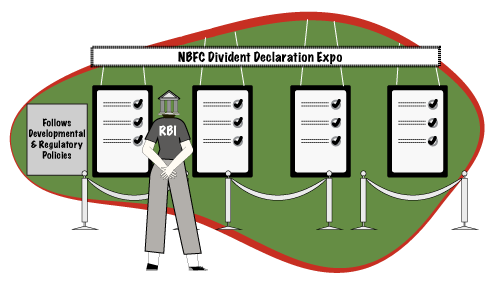Decleration of Dividends by NBFCs

On 4th December 2020, the Reserve Bank of India (RBI) had issued a Statement on Developmental and Regulatory Policies. The statement contained various developmental and regulatory measures to enhance liquidity and develop the economy, conserve capital among Banks and NBFCs and strengthen supervision /regulatory practices with the objective of improving ease of doing business in the country. An important part of the statement was putting regulatory practices in Banks and NBFCs.
Pursuant to the statement, on 9th December 2020 the RBI came out with the draft circular proposing guidelines governing the declaration of dividends by NBFCs. NBFCs have been classified into various categories depending on their asset size. The rationale for such classification is that the activities of such NBFCs will have a bearing on the financial stability of the overall economy. Better regulatory governance is another criterion. A look at the highlights:
PARTICULARS
PARTICULARS
REMARKS
APPLICABILITY
–
For all NBFCs effective 1st April 2020 (FY 2020-21)
ELIGIBILITY CRITERIA
Only those NBFCs complying with the minimum prudential requirements can declare dividend.
Capital Adequacy & Leverage
Deposit taking NBFC (NBFC-D)
NBFCs that accept fixed public deposits subject to they being registered so.
Systemically Important Non-Deposit taking NBFC (NBFC-ND-SI)
NBFCs whose asset size is of ₹ 500 cr or more as per last audited balance sheet.
Should have *Capital adequacy ratio (CRAR) of at least 15% for last 3 years, including the accounting year for which it proposes to declare dividend
Non-Systemically Important Non-Deposit taking Non-Banking Financial Company (NBFC-ND)
NBFCs whose asset size is less than ₹ 500 cr as per last audited balance sheet.
Should have leverage ratio of less than 7 for the last 3 years, including the accounting year for which it proposes to declare dividend.
Non-performing Assets (NPA)
Core Investment Company (CIC)
An NBFC which carries on the business of acquisition of shares and securities and holds not less than 90 per cent of its net assets in the form of investment in equity shares, preference shares, bonds, debentures, debt or loans in group companies.
Should have Adjusted Net Worth (ANW) of at least 30% of its aggregate risk weighted assets on balance sheet and risk adjusted value of off-balance sheet items for last 3 years, including the accounting year for which it proposes to declare dividend.
–
The net NPA ratio should be less than 6% in each of the last three years, including the accounting year for which it proposes to declare dividend.
Other Criteria
–
(i) NBFCs should comply with the provisions of Section 45 IC of the RBI Act, 1934 and other guidelines
(ii) The proposed dividend should be payable only out of the current year’s profit.
(iii) No explicit restrictions should have been placed by the RBI.
QUANTUM OF DIVIDEND PAYABLE
- The dividend pay-out ratio for various categories of NBFCs shall be as per fixed ratio / rates fixed as per Matrix by the RBI.
- Profits for calculating dividend should exclude extra ordinary items, if any.
- There should be no auditors’ qualification of financials that will impact profits out of which dividends will be declared. Net profit should be suitably adjusted while computing dividend.
- In case the NBFC has a different CRAR and a Core investment Co has different **ANW in the last 3 years, dividend pay-out will be determined based on the lower of the two.
- Dividend pay-out ratio shall be calculated as a percentage of ‘dividend payable in a year’ to ‘net profit during the year’.
- Dividend pay-out ratio shall not exceed 60 % for SPDs having CRAR at 20% or above during all the four quarters of the accounting year in which dividend is proposed.
Reporting
NBFC-D, NBFC-ND-SI & CICs declaring dividend should report details of dividend declared during the accounting year in the format prescribed by the RBI in the guidelines.
The report should be furnished within a fortnight after declaration of dividend to the Regional Office of the Department of Supervision of the Bank, under whose jurisdiction it is registered.
The RBI draft circular states that these guidelines have been proposed to infuse greater transparency and uniformity in practice besides improving ease of doing business. These guidelines are the first step towards regulating the hitherto unregulated segment of dividends in NBFCs. A welcome move considering the increasing importance of NBFCs in the Indian economy.
*Capital adequacy ratio or CRAR – A measurement (in %) of Bank’s available capital vis- a-vis the Bank’s credit exposures. This is used to protect depositors and promote stability and efficiency of financial systems.
** Adjusted Net Worth or ANW – A capital requirement concept in CICs wherein the ANW should not be less than 30% of the risk weighted assets.

